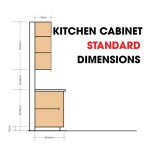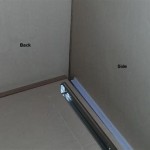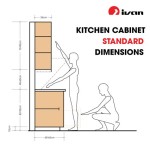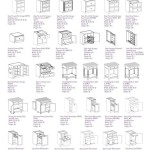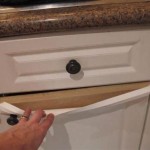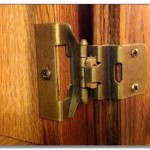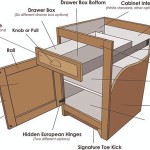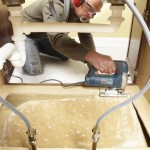Kitchen Cabinets: Integrating Small Appliance Storage for Enhanced Functionality
The modern kitchen is often a hub of activity, requiring careful consideration of design and organization to maximize efficiency and maintain an aesthetically pleasing environment. Small appliances, while essential for various culinary tasks, can quickly contribute to countertop clutter if not properly stored. Integrating strategic small appliance storage within kitchen cabinets is crucial for optimizing space, improving accessibility, and enhancing the overall functionality of the kitchen.
Effective small appliance storage involves careful planning during the kitchen design phase or strategic retrofitting of existing cabinetry. Several factors influence the optimal approach, including the size and frequency of use of each appliance, the overall kitchen layout, and the homeowner's lifestyle and preferences. Thoughtful integration ensures appliances are readily available when needed yet remain discreetly tucked away when not in use, promoting a clean and organized workspace.
Optimizing Cabinet Space for Small Appliances
The initial step in designing effective small appliance storage is to conduct a thorough inventory of all appliances to be accommodated. This includes not only identifying each appliance but also assessing its dimensions, weight, and cord length. Appliances used frequently should be stored in easily accessible locations, while those used less often can be relegated to higher shelves or more remote cabinets. Categorizing appliances based on usage frequency allows for a more efficient storage arrangement.
Standard base cabinets can be adapted for small appliance storage through various modifications. Installing pull-out shelves allows for easy access to appliances stored at the back of the cabinet. These shelves can be constructed of wood, metal, or durable plastic and should be rated to support the weight of the appliances they will hold. Full-extension slides are generally preferred for pull-out shelves, as they allow for complete access to the stored items. Adjustable shelving is also beneficial, as it allows for customization based on the height of the appliances.
Corner cabinets, often underutilized spaces, can be transformed into effective small appliance storage areas with the use of specialized hardware. Lazy Susans or rotating shelves can maximize accessibility to items stored deep within the corner cabinet. Kidney-shaped shelves or pie-cut shelves can also be employed to effectively utilize this challenging space. Another option is to install a blind corner pull-out system, which allows for full access to the contents of the blind corner. These systems typically consist of a series of shelves that pull out and swing to provide complete visibility and accessibility.
Tall pantry cabinets offer ample vertical space for storing a variety of small appliances. Adjustable shelves are essential in pantry cabinets to accommodate appliances of different heights. Consider incorporating vertical dividers to separate appliances and prevent them from shifting during storage. Pull-out drawers within the pantry cabinet can be used to store accessories such as blender attachments, food processor blades, and extra cords. Adequate lighting within the pantry cabinet is crucial for easily identifying and retrieving stored appliances.
Countertop garages, also known as appliance garages, provide a dedicated space for storing small appliances while keeping them readily accessible. These garages typically feature a hinged door that can be lifted to reveal the appliance and then closed to conceal it when not in use. Countertop garages can be custom-built to match the existing cabinetry or purchased as prefabricated units. They are particularly useful for storing appliances that are used frequently, such as coffee makers, toasters, and blenders. The interior of the garage can be equipped with an electrical outlet to allow the appliance to remain plugged in while stored.
Innovative Storage Solutions and Hardware Considerations
Beyond traditional cabinet modifications, several innovative storage solutions are available to further optimize small appliance storage. Lift-up shelves, for example, allow for easy access to heavy appliances without the need for lifting. These shelves are typically mounted on a spring-loaded or gas-assisted mechanism that allows them to be raised and lowered with minimal effort. They are particularly suitable for appliances such as stand mixers and food processors.
Drawer dividers and organizers are essential for maximizing storage efficiency within drawers. These organizers can be used to separate and contain small appliances and their accessories, preventing them from becoming jumbled together. Adjustable drawer dividers allow for customization based on the size and shape of the items being stored. Specialized drawer inserts are available for storing specific types of appliances, such as knife blocks and spice racks.
Roll-out carts or islands can provide additional storage space for small appliances, particularly in kitchens with limited cabinet space. These carts can be moved around the kitchen as needed and stored in a pantry or closet when not in use. Some roll-out carts feature a built-in cutting board or drop-leaf extension, providing additional workspace. Ensure the cart is equipped with locking casters to prevent it from rolling unexpectedly.
Selecting the appropriate hardware is crucial for ensuring the functionality and durability of small appliance storage solutions. Hinges, drawer slides, and shelf supports should be rated to support the weight of the appliances they will be holding. Soft-close hinges and drawer slides can help to prevent slamming and reduce noise. Consider using heavy-duty adjustable shelf supports to prevent shelves from sagging under the weight of heavy appliances. The finish of the hardware should complement the overall design of the kitchen.
When installing pull-out shelves or drawers, consider the placement of the hardware to ensure that it does not interfere with the operation of the appliance. For example, drawer slides should be positioned to allow for full access to the appliance without obstructing the door or handle. Hinges should be selected to allow the door to open fully without hitting adjacent cabinets or walls.
Planning for Electrical Access and Cord Management
One of the most critical considerations for small appliance storage is providing adequate electrical access. Appliances stored within cabinets or countertop garages should have access to a nearby electrical outlet to allow them to be used without having to be moved. Electrical outlets can be installed inside the cabinet or on the back wall, depending on the configuration of the space. It is important to consult with a qualified electrician to ensure that the electrical installation meets all applicable codes and safety standards.
Cord management is another essential aspect of small appliance storage. Long, tangled cords can create clutter and pose a safety hazard. Consider using cord organizers to keep cords neatly bundled and out of the way. Cord winders, clips, and ties can be used to shorten cords and prevent them from tangling. Some cabinets feature built-in cord management systems, such as grommets or cord channels, that allow cords to be routed neatly through the cabinet.
When planning for electrical access, consider the amperage requirements of the appliances that will be stored in the cabinet. High-wattage appliances such as stand mixers and food processors may require a dedicated circuit to prevent overloading the electrical system. Consult with an electrician to determine the appropriate circuit size and amperage for each appliance.
Install ground fault circuit interrupters (GFCIs) in all electrical outlets located near water sources, such as sinks and dishwashers. GFCIs are designed to protect against electrical shock by quickly shutting off the power in the event of a ground fault. This is particularly important in kitchens, where water is frequently present.
Consider installing under-cabinet lighting to illuminate the countertop and make it easier to see the appliances stored within the cabinets. Under-cabinet lighting can be installed using LED strip lights, puck lights, or fluorescent fixtures. Choose a lighting option that provides adequate illumination without creating glare.
In conclusion, strategically integrating small appliance storage into kitchen cabinets is a key component of a functional and well-organized kitchen. By carefully planning and implementing innovative storage solutions, homeowners can maximize space, improve accessibility, and enhance the overall aesthetic appeal of their kitchens. Consideration must be given to the specific needs and preferences of each household to ensure that the storage solutions are tailored to their lifestyle. Effective electrical access and cord management are also vital to ensure the safe and convenient operation of small appliances.
:strip_icc()/101932029-1be3c4c8bd204fd48ea29936719415b2.jpg?strip=all)
20 Small Appliance Storage Ideas To Reduce Countertop Clutter

40 Appliance Storage Ideas For Smaller Kitchens Small Kitchen Solutions

Kitchen Appliances Storage Ideas Neat House Sweet Home

66 Creative Appliances Storage Ideas For Small Kitchens Digsdigs

Appliance Storage Cabinet Kitchen Appliances Small

11 Sneaky Storage Ideas For Small Appliances

50 Kitchen Appliance Storage Ideas For Small Appliances

Managing Small Appliance Storage In Your Home

How To Small Appliances Inside Kitchen Cabinets The Homes I Have Made

Why Your Custom Kitchen Needs A Garage An Appliance Art Design
Related Posts

